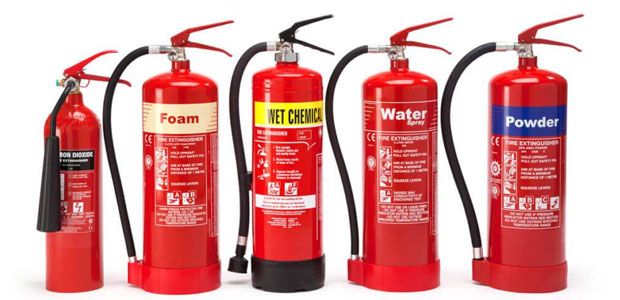Extinguisher Myths Explained
This FAQ document is a great post written by "Anthony Buck" and sets out to dispel incorrect information often given out to company Fire safety or Company Health & Safety officers.
1) Fire Extinguishers must be replaced after 10 years
Answer – NO
There is No statutory minimum service life of an extinguisher.
Some bodies recommend a 20 year limit but in practice the FSH2 committee who advise British Standards shied away from giving any extinguisher a limit, therefore, an extinguisher can continue in service indefinitely whilst
• Parts remain available
• The extinguisher has no damage, defect, or corrosion rendering it unsafe for use.
• It is not an obsolescent type
• It is serviced, including extended service (CO2 statutory overhaul) as required.
2) If a Fire extinguisher hasn’t been serviced for a few years it must be replaced.
Answer – NO
It just means that a service is all the more urgent. As long as parts are available and it passes it`s basic extended service or overhaul (as required) and is not obsolescent it can continue to be used.
3) Old colour coded extinguisher are obsolete and must be replaced.
Answer – NO
Many pre BS EN3 extinguishers manufactured to BS 5423 still have suitable spares & parts available and may continue in service as long as they pass inspection. However, it is not advisable to mix & match old colour BS5423 units with BS EN3 units to avoid confusion.
4) Fire extinguishers must be replaced at their 5 yearly discharge test (Extended Service) as it is not cost effective to carry this out.
Answer – NO
What they mean is it`s too time consuming for them to carry out this test and they`d rather replace it.
5) Stainless steel / Polished extinguishers are illegal.
Answer – NO
Although they cannot be Kite marked to BS EN3 due to their colour, where preferred for aesthetic reasons they remain perfectly legal as long as new models are CE marked and correct signage is in place.
6) CO2 extinguishers must have a 5 yearly extended test.
Answer – NO
For a short time around 2000 the servicing standard BS 5306-3 did require this but after feedback from manufacturers this was removed in the 2003 revision as not required or of value.
7) CO2 extinguishers must be replaced after 10 years.
Answer – NO
It may be profitable and less time consuming for the engineer to do this, but what is actually required at 10 years is a statutory overhaul which includes a hydraulic pressure test (to meet requirements of the Pressure Equipment Directive). This will include a shot blast, repaint, new dip tube, new valve & relabelling with 10 year guarantee so there is no advantage in buying new replacement equipment. The preferred method is to service exchange for a unit already overhauled.
8) Every Kitchen requires a Powder extinguisher & Fire Blanket
Answer – NO
Extinguisher provision is Risk based and most Kitchens in premises are just tea points / breakout areas with a kettle, microwave dishwasher etc. A Fire blanket is not needed if there is no small class `F` fire risk (no cooker with hob) that a chip pan or frying pan could be used on. Powder extinguishers are not very effective on enclosed electrical equipment such as microwaves and may cause severe secondary damage. A CO2 nearby would be more appropriate.
Note:
It should also be noted that recent recommendations within the industry are to remove powders from inside office/home environments due to the fact that on discharge they immediately reduce visibility and incite possible breathing problems for persons who may be suffering Asthma / COPD conditions, as well as hamper evacuation / rescue.
9) Fire extinguisher personnel are experts.
Answer – NO
Sad to say but the Fire extinguisher trade is sales and target driven and excuses will be made to sell new equipment to earn commissions.
10) Are my extinguishers being serviced correctly.
Answer – Maybe Yes maybe NO
Corners are sometimes cut to save time/money or purely through ignorance and inadequate training. Im afraid there is a term in the trade called “Sign & Shine” or "Rag & Tag", a term for wiping the extinguisher down so it looks like it`s been attended to but `O` rings have not been checked, hoses have not been tested for perishing, CO2 Horns not properly tightened and pressure gauges not properly tested.
Label terminology to check;
a correctly completed label should include:
• Date Serviced (Year & Month)
• Next Service due
• Type of service (initial-Basic-Extended-Recharge-or Overhaul
• Weight in kg
• Next Extended service
• Engineers initials or number
Should you have any concerns there are certified quality auditors within the industry.
11) What genuine reasons exist for condemning / replacing an extinguisher
Answer
Even correctly serviced equipment will deteriorate over time and become unsafe because of the pressures used to charge the equipment. Reason for Condemning / Replacing;
• Corrosion, wear or damage to threads of any pressure retaining part
• Corrosion on welds
• Extensive external corrosion / pitting
• Significant dents / gouges on the body
• Splits, lifting or bubbling of internal plastic linings
• Overpainting or application of any covering other than that intended when manufactured.
• Obsolete models
Should there be anything further you wish to ask, please do message or call.

